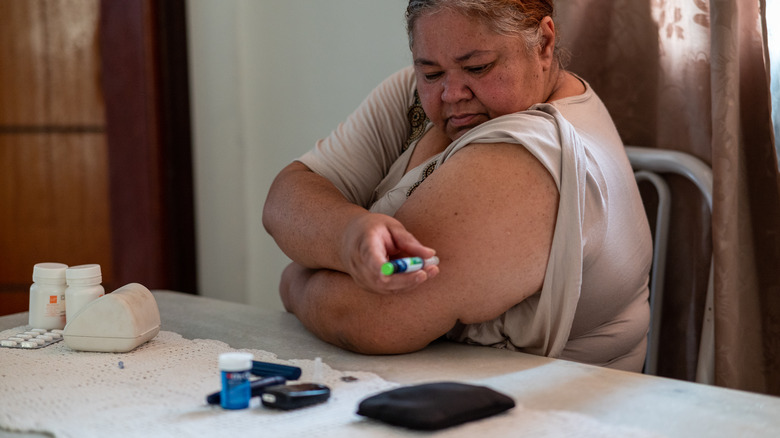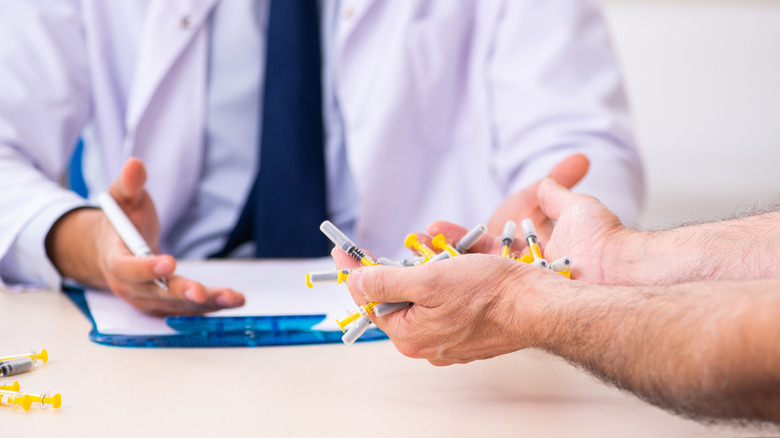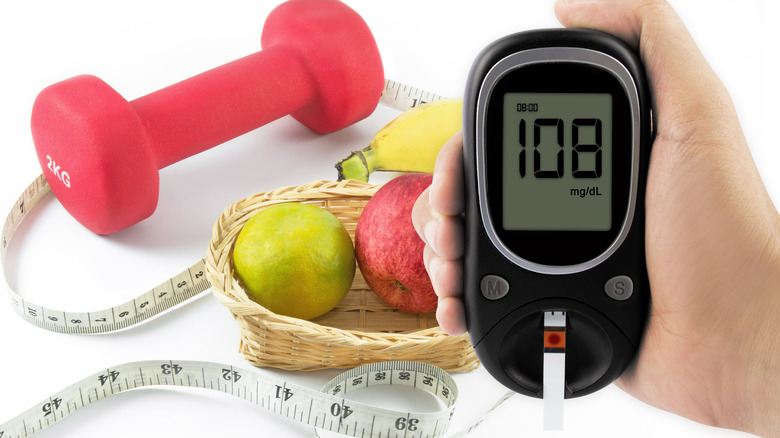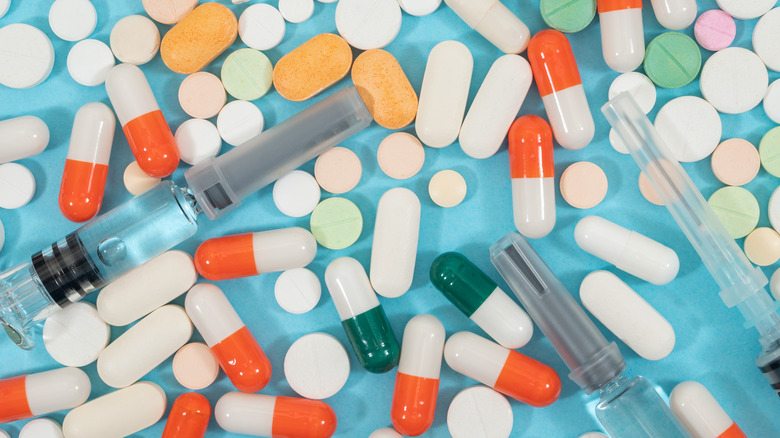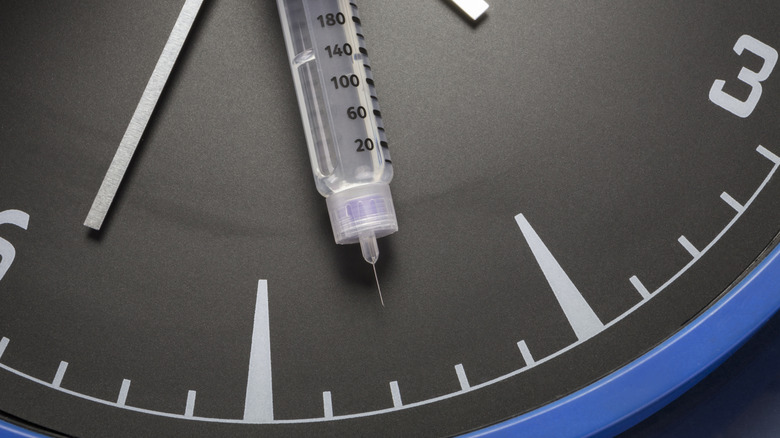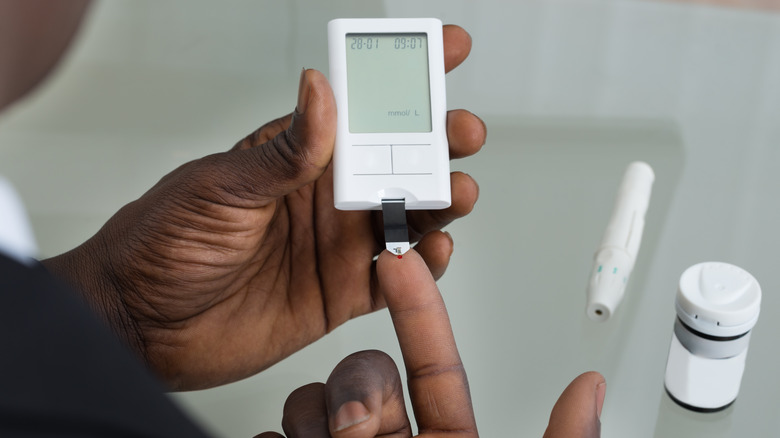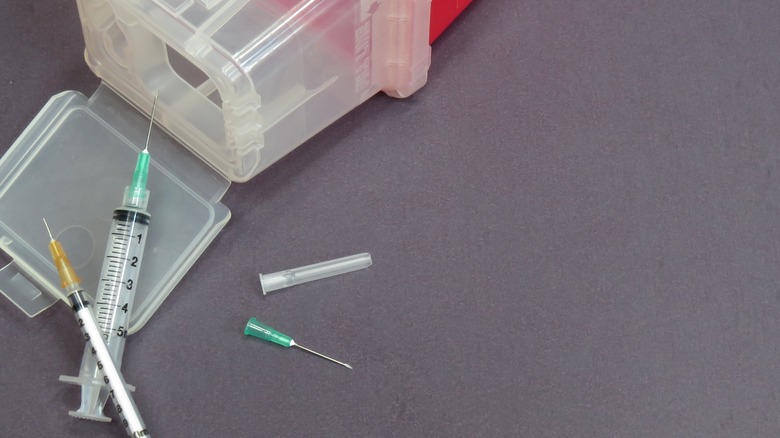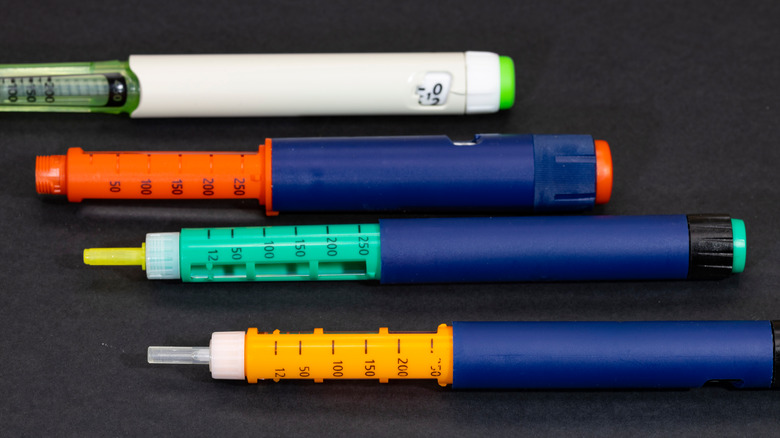Trulicity Explained: Uses, Dosage, Side Effects
Diabetes has become such a commonplace medical term within our society that all of us probably know at least one person who has the disease. This is not surprising, considering the fact that the Centers for Disease Control and Prevention (CDC) estimates that 11.3% of the total population in the United States (or more than 1 in 10 Americans) are diabetic.
There are three different types of diabetes mellitus: type 1, type 2, and gestational (via WebMD). All three types lead to the accumulation of sugar (glucose) in the body, but the manner in which this happens is distinct between the different types. Type 1 diabetes is an autoimmune (often genetic) condition wherein the body is unable to produce enough insulin, one of the hormones that help maintain normal glucose levels in the body. On the other hand, type 2 diabetes occurs when the body becomes insensitive to insulin, even in cases where the body is able to produce adequate amounts. This typically occurs in people who are overweight or obese. Gestational diabetes is similar to type 2 diabetes but exclusively occurs in pregnant women, as pregnancy can cause the body to become resistant to insulin temporarily.
Because diabetes continues to be one of the biggest health crises we face today, several types of drugs have been manufactured to help diabetics control their sugar levels. Unfortunately, there is not one drug that is effective for all, and people with diabetes may sometimes find themselves needing more than one type of medication.
What is Trulicity?
Trulicity is a brand name of a type of anti-diabetic drug called dulaglutide. It was first approved by the U.S. Food and Drug Administration (FDA) in 2014 for people with type 2 diabetes. It is an injection drug that comes in disposable, prefilled syringes in doses of 0.75, 1.5, 3, and 4.5 milligrams. One injection pen contains one dose. It is injected in the abdomen, thigh, or upper arm once a week at any time of the day, with or without food.
According to Healthline, if you are starting treatment with Trulicity, your doctor will most likely prescribe the lowest dose initially and regularly monitor your blood glucose levels. If your sugar remains uncontrolled, they will increase your dose to the next level. If your levels are still too high after several weeks, they will continue to increase the dose slowly until your glucose levels normalize or until you reach the maximum dose of 4.5 milligrams. If at the maximum dose your sugar is still uncontrolled, you may be switched to a different medication, or your doctor may add another type of drug. If your sugar levels get too low, however, your doctor may decrease the dose.
Dulaglutide is a biologically active drug that is only available in its brand-name form Trulicity. Currently, there are no generic or biosimilar forms available for this specific medication (per Medical News Today). Without insurance or depending on the type you have, Trulicity can cost around $1,000 a month (via Lilly).
How Trulicity helps people with type 2 diabetes
Trulicity (aka dulaglutide) works as a glucagon-like peptide-1 (GLP-1) receptor agonist, which means that it acts similarly to GLP-1 (via StatPearls). It attaches to the GLP-1 receptor and activates it. GLP-1 is a hormone that can amplify the effect of insulin on the body, as well as suppress glucagon, which is the opposing hormone of insulin responsible for raising sugar levels in the body. GLP-1 can also promote the feeling of fullness, improve heart function, and increase glucose uptake in the muscles. Because these natural effects of GLP-1 are often diminished or absent in people with type 2 diabetes, GLP-1 receptor agonists like Trulicity makes for an ideal treatment option. Additionally, not only can GLP-1 receptor agonists prevent the destruction of cells in the pancreas that secrete insulin, but they can also help increase their numbers.
According to research studies, it takes around one to two days for your body to fully absorb the drug after you inject it (per DrugBank Online). Its half-life is close to four days, which means that it takes that much time before the concentration of Trulicity in your body gets cut in half. This is the reason why injections only need to be done once a week.
Indications of Trulicity
In general, adults and children over 10 years old with type 2 diabetes can be given Trulicity. However, this injection drug should be used as an additional and supporting treatment option, on top of proper diet and regular physical activity (per Drugs.com). In 2020, the FDA also approved Trulicity for use in people with type 2 diabetes with existing heart disease or several risk factors that increase their risk of developing heart disease. Trulicity is the first (and currently only) anti-diabetes drug approved for this use, after it showed very promising and favorable results from a large clinical trial. These include decreased risk of heart attacks, strokes, and death (via Lilly).
In addition to these primary indications, your doctor may also prescribe Trulicity if you have type 2 diabetes and are overweight or obese. Although Trulicity is not indicated for weight loss treatment, SingleCare states that it is sometimes prescribed off-label for this purpose. Not everyone on Trulicity will experience weight loss, though; some may even gain weight. Weight loss from Trulicity is most likely due to its effect of slowing gut movement, therefore giving a prolonged sense of fullness. Following this, diabetics on Trulicity may eat less, consume less calories, and consequently lose weight.
There are drugs in the same class as Trulicity (e.g., liraglutide, semaglutide) that are FDA-approved for weight loss. Unfortunately, because of increasing popularity and demand for these anti-diabetic medications that can help with weight loss, many of them are currently in shortage (via Accountable Health Partners).
Known side effects of Trulicity
The most common side effects of Trulicity involve the gastrointestinal tract. These include decreased appetite, abdominal pain or discomfort, acid reflux, heartburn, belching, nausea, vomiting, and diarrhea. You may also feel weak, tired, or fatigued. Specifically at the area where you inject the drug, you may develop pain, tenderness, stinging, tingling, warmth, redness, swelling, scarring, pressure sensation, hives, itching, numbness, discoloration, bleeding, blistering, or ulcerations.
Like with any other drug, you can also develop an allergic reaction, which ranges from mild rash and itching to life-threatening swelling of the face, lips, throat, hands, and feet. Some people may also experience damage to their pancreas or gallbladder, which can manifest as severe abdominal pain, uncontrollable vomiting, yellowing of the white part of the eyes and skin, clay-colored stools, and dark urine. Other serious side effects and associated complications can include dehydration (decreased urine, dry mouth, headache, sunken eyes, wrinkled skin), mood changes (agitation, hostility, depression, irritability), rapid heartbeat, tightness in the chest, difficulty breathing, problems with swallowing, confusion, lethargy, lightheadedness, dizziness, fainting, seizures, fever, chills, cold sweats, pale skin, hoarseness, twitching of muscles, increased hunger, rapid weight gain, and constipation.
Speak with your doctor or pharmacist if you are experiencing symptoms after taking Trulicity. If your symptoms are constant, severe, or progressively getting worse, go to the nearest emergency room to get medical help as soon as you can.
Medications and other substances that can interact with Trulicity
Medications that can interact with Trulicity include carbamazepine, clonidine, cyclosporine, digoxin, disopyramide, ethosuximide, fosphenytoin, lithium, lonapegsomatropin, miglitol, minoxidil, phenytoin, prazosin, primidone, procainamide, quinidine, quinine, sirolimus, somapacitan, tacrolimus, theophylline, tolbutamide, and valproic acid.
It is not uncommon for people with type 2 diabetes to be on more than one type of anti-diabetic medication. While these drugs do not necessarily interact with one another, it is worth noting that generally, the more anti-diabetic drugs you take, the more you are at risk of having episodes of low blood sugar. These medications include insulin (e.g., glargine, detemir, degludec), metformin, sulfonylureas (e.g., glimepiride, glipizide, glyburide), meglitinides (e.g., nateglinide, repaglinide), DPP4-inhibitors (e.g., linagliptin, sitagliptin), SGLT-2 inhibitors (e.g., canagliflozin, empagliflozin), acarbose, thiazolidinediones (e.g., pioglitazone, rosiglitazone), and pramlintide.
Currently, there are no foods, herbs, or supplements that are known to interact with Trulicity. If you are on Trulicity, it is best to err on the side of caution and consult with your doctor first before taking any new medications or supplements. If you are prescribed something that you have never taken with Trulicity before (even if it is for a completely separate health problem), ask your doctor or pharmacist if it can have any effects on Trulicity. Likewise, if you are just about to be started on Trulicity, make sure to tell your doctor or pharmacist about any medications or supplements that you are currently taking, especially the ones that they do not know about, if any.
Who should not take Trulicity?
The FDA has placed a black box warning on Trulicity, cautioning people that the medication has been proven to cause thyroid cancer in rodents, and its risk in humans cannot be determined (per Drugs.com). Therefore, people who have a personal or family history of medullary thyroid carcinoma, and people with multiple endocrine neoplasia syndrome type 2, should never be given Trulicity. People who are allowed to take Trulicity should watch out for symptoms of thyroid tumors such as neck mass, difficulty swallowing, shortness of breath, and hoarseness. Otherwise, screening for thyroid tumors is not necessary.
People who have had severe allergic reactions to Trulicity, its ingredients, and other GLP-1 receptor agonists, should not be on Trulicity. Other health conditions that may occur or become worsened by taking Trulicity include acute and chronic kidney failure, gallbladder diseases (e.g., gallstones, infection), acute pancreatitis, severe gastrointestinal diseases, and diabetic eye disease.
Trulicity has also been shown to cause fetal developmental problems in animal studies, but it is still unclear in humans. What is known, however, is that uncontrolled diabetes can lead to several pregnancy and delivery complications. Therefore, safer anti-diabetic drug options should be explored first, and if a pregnant woman's blood sugar remains uncontrolled, Trulicity should only be used if its benefits far outweigh its potential risk. For breastfeeding, there is currently no data that shows that Trulicity can get transferred into breast milk, nor is there any data on its effects on breastfed babies and breastmilk production (via Medscape).
What can happen if you miss a dose of Trulicity
Lilly Medical explains that the concentration of Trulicity in the body can reach a steady state after around two to four weeks of regular weekly injections. Once a person reaches this state, forgetting two or more consecutive injections can cause the concentration of Trulicity to drop below its therapeutic level.
According to the FDA, the day of the week you choose to give yourself the injection does not need to be the same day every week. You can change it to a different day, as long as your last injection was done three or more days before the next one. In other words, if you miss a dose, give yourself an injection as soon as you can if you have at least three more days before your next scheduled dose. If you have less than three days, do not give yourself an injection and wait until your upcoming scheduled dose (per Mayo Clinic).
Before using Trulicity, your doctor will teach you or your caregiver how to properly inject the drug. To avoid improper technique (and possibly administering an incomplete dose), it is best to have the same person give you the injection at all times.
What to do if you overdose on Trulicity
There is such a thing as giving yourself too much Trulicity. Whether it was accidental (e.g., injector pen malfunction) or intentional, signs and symptoms of Trulicity overdose can include gastrointestinal symptoms (e.g., nausea, vomiting) and low blood sugar levels. Reports of these from clinical studies have been relatively mild, but if you are experiencing severe symptoms, do not hesitate to call 911 or go to your nearest emergency room (per Medical News Today).
There is no antidote for Trulicity overdose, but your doctor will treat you based on your specific signs and symptoms (via Lilly Medical). Low blood sugar can cause a wide variety of symptoms, including shakiness, anxiousness, irritability, chills, sweating, confusion, lightheadedness, sleepiness, headaches, tingling or numbness, imbalance, weakness, blurring of vision, seizures, fast heartbeat, hunger, and nightmares. The American Diabetes Association (ADA) explains that if your blood sugar drops to less than 70 milligrams per deciliter and you are having only mild symptoms, you can attempt to correct your sugar level at home. You can do this by consuming around 15 grams of carbohydrate and checking your blood sugar after 15 minutes. Continue to do this until your sugar level reaches at least 70 milligrams per deciliter. It is important that you correct your sugar slowly to avoid sudden spikes. However, if you have severely low blood sugar, you may need a glucagon injection.
How to properly store and dispose of Trulicity
According to Medscape, you should store your prefilled Trulicity injector pens in the refrigerator with temperatures between 36 and 46 degrees Fahrenheit (2 to 8 degrees Celsius). You can also keep them at room temperature for two weeks, as long as it is away from direct heat and kept at temperatures below 86 degrees Fahrenheit (30 degrees Celsius). It is recommended that you keep your injector pens inside their original box until you need to use it. Do not put Trulicity in the freezer and do not use them once they have already frozen. If injecting cold liquid is unpleasant for you, Drugs.com suggests warming up your injector pen between your hands, or letting it warm up to room temperature on its own for at least 30 minutes before administering the drug. Do not microwave it, and do not submerge it in boiling water or put it against a stove, as this can damage the drug.
To properly dispose Trulicity, Healthgrades advises to speak with your doctor or pharmacist. Protocols for sharps disposal can vary per state, and your local pharmacist and healthcare provider will know where the best place is to dispose of your needles. Alternatively, you can make your own temporary container at home using closed containers made with heavy-duty plastic. Make sure to label it to avoid any unwanted injuries. Remember to always put the cap back on before throwing away your needles, and do not flush them down the toilet.
Other drugs similar to Trulicity
Medical News Today lists the different GLP-1 receptor inhibitors as exenatide (e.g., Bydureon, Byetta), liraglutide (e.g., Victoza, Saxenda), lixisenatide (e.g., Adlyxin), and semaglutide (e.g., Ozempic, Wegovy, Rybelsus). All of these medications work similarly to Trulicity. A closely related drug called tirzepatide (e.g., Mounjaro), belonging to a brand new class of anti-diabetic medication, works as a combined GLP-1/GIP receptor agonist.
GoodRx explains what is unique about each of these drugs. Byetta is a twice daily injection given an hour before meals, while Bydureon is a once weekly injection. Neither Byetta or Bydureon have protective effects on the heart. Victoza and Saxenda are the same drugs, except Victoza is given to people with type 2 diabetes and is not approved for weight loss, while Saxenda is given to obese adults and adolescents and is approved for weight loss. Similarly, Ozempic and Wegovy are the same drugs, but Ozempic is for diabetics and Wegovy is for weight loss. Victoza and Saxenda are once daily injections, while Ozempic and Wegovy are once weekly. In clinical trials, people who took Mounjaro had better sugar control and more weight loss compared to people who took Ozempic. Currently, Mounjaro is only approved for diabetics, and is still not approved for weight loss.
Additionally, in 2019, the FDA approved the first-ever oral GLP-1 receptor agonist. Rybelsus is the same as Ozempic and Wegovy, except manufacturers of the drug were able to convert it from an injection drug to tablet form.
Benefits of Trulicity compared to other anti-diabetic medications
There are generally two types of type 2 diabetes medications: oral and injection. While the thought of regularly injecting your body with a needle is enough to scare just about anyone, the injection form of anti-diabetes drugs are actually quite popular.
Similar to the injectables, there are several classes of oral diabetes medications, with each of them working distinctly from one another. Some decrease the formation of glucose in the liver, others stimulate your body to produce more insulin, and there are ones that can even help your body become more sensitive to insulin. However, all oral diabetes drugs have to be taken at least once a day. Oftentimes, depending on which type of oral medication you are taking, you may even need to take them two or three times a day. This can be disruptive to your everyday life and can make you more prone to missing doses. On the other hand, injectables are given less frequently, ranging anywhere from once daily to once weekly (via the University of California).
Injectable drugs like Trulicity also have the added advantage of making use of several mechanisms to help lower blood sugar levels. They can also help with weight loss, and possibly protect against heart and kidney disease (via Healthline). While most people are often started with oral medication for diabetes treatment, if your sugar level consistently remains uncontrolled, it is more than likely that your doctor will eventually add an injectable medication to help normalize it.

